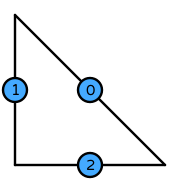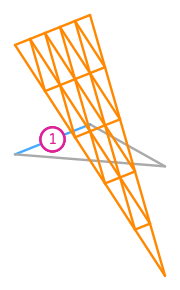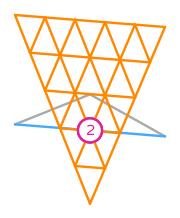an encyclopedia of finite element definitions
Degree 1 Morley–Wang–Xu on a triangle
◀ Back to Morley–Wang–Xu definition page
- \(R\) is the reference triangle. The following numbering of the subentities of the reference cell is used:
- \(\mathcal{V}\) is spanned by: \(1\), \(x\), \(y\)
- \(\mathcal{L}=\{l_0,...,l_{2}\}\)
- Functionals and basis functions:

\(\displaystyle l_{0}:\mathbf{v}\mapsto\displaystyle\int_{e_{0}}v\)
where \(e_{0}\) is the 0th edge.
\(\displaystyle \phi_{0} = 1 - 2 y\)
This DOF is associated with edge 0 of the reference cell.
where \(e_{0}\) is the 0th edge.
\(\displaystyle \phi_{0} = 1 - 2 y\)
This DOF is associated with edge 0 of the reference cell.
\(\displaystyle l_{1}:\mathbf{v}\mapsto\displaystyle\int_{e_{1}}v\)
where \(e_{1}\) is the 1st edge.
\(\displaystyle \phi_{1} = 1 - 2 x\)
This DOF is associated with edge 1 of the reference cell.
where \(e_{1}\) is the 1st edge.
\(\displaystyle \phi_{1} = 1 - 2 x\)
This DOF is associated with edge 1 of the reference cell.


